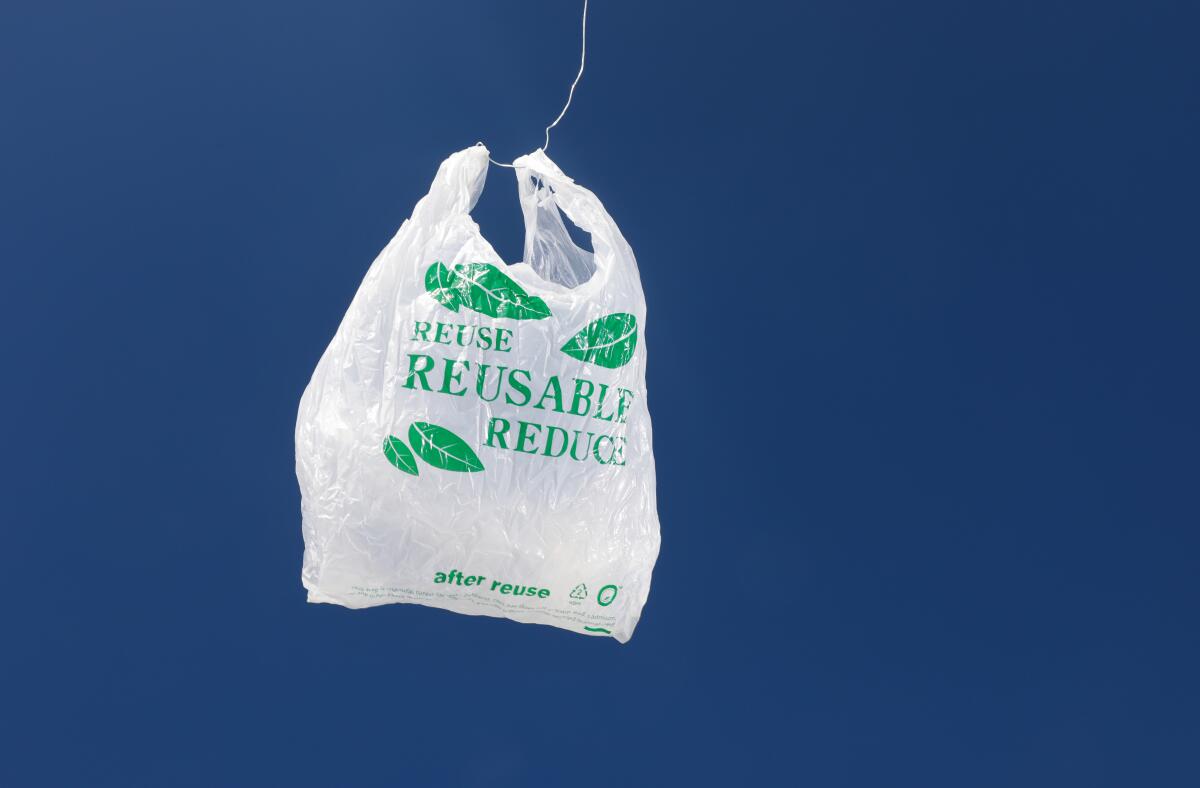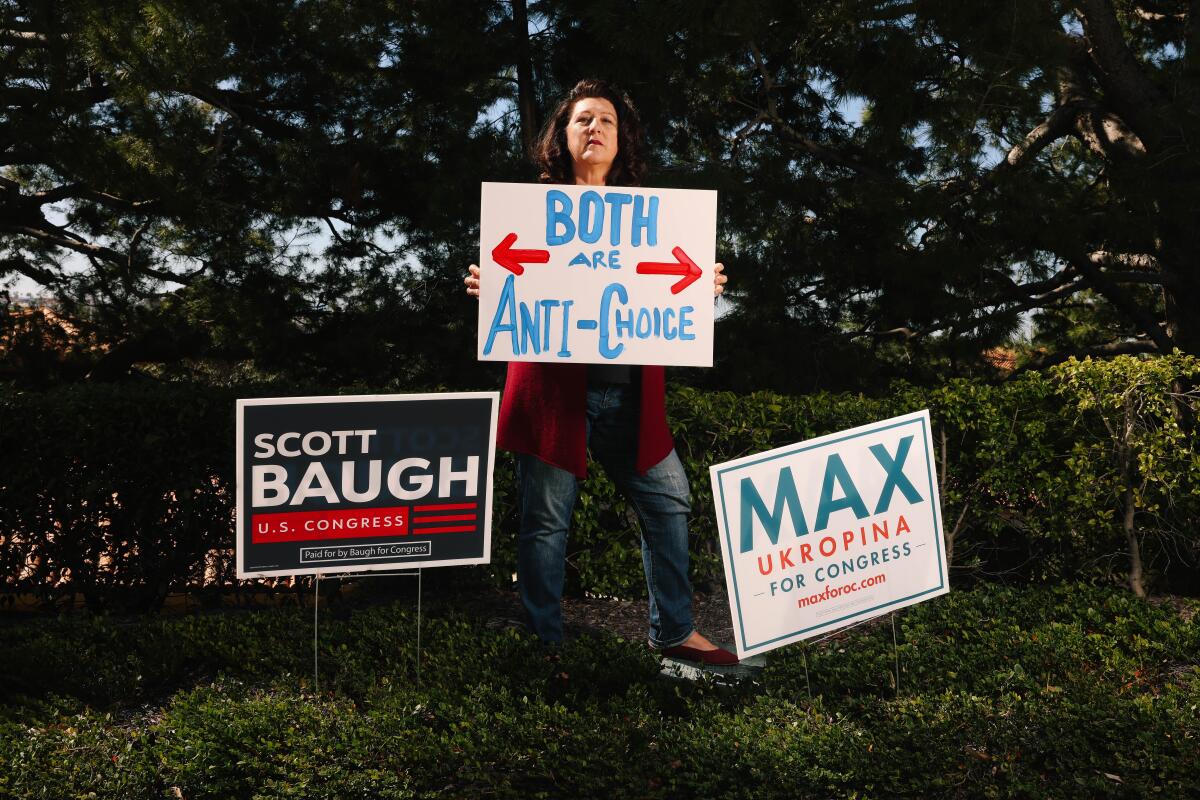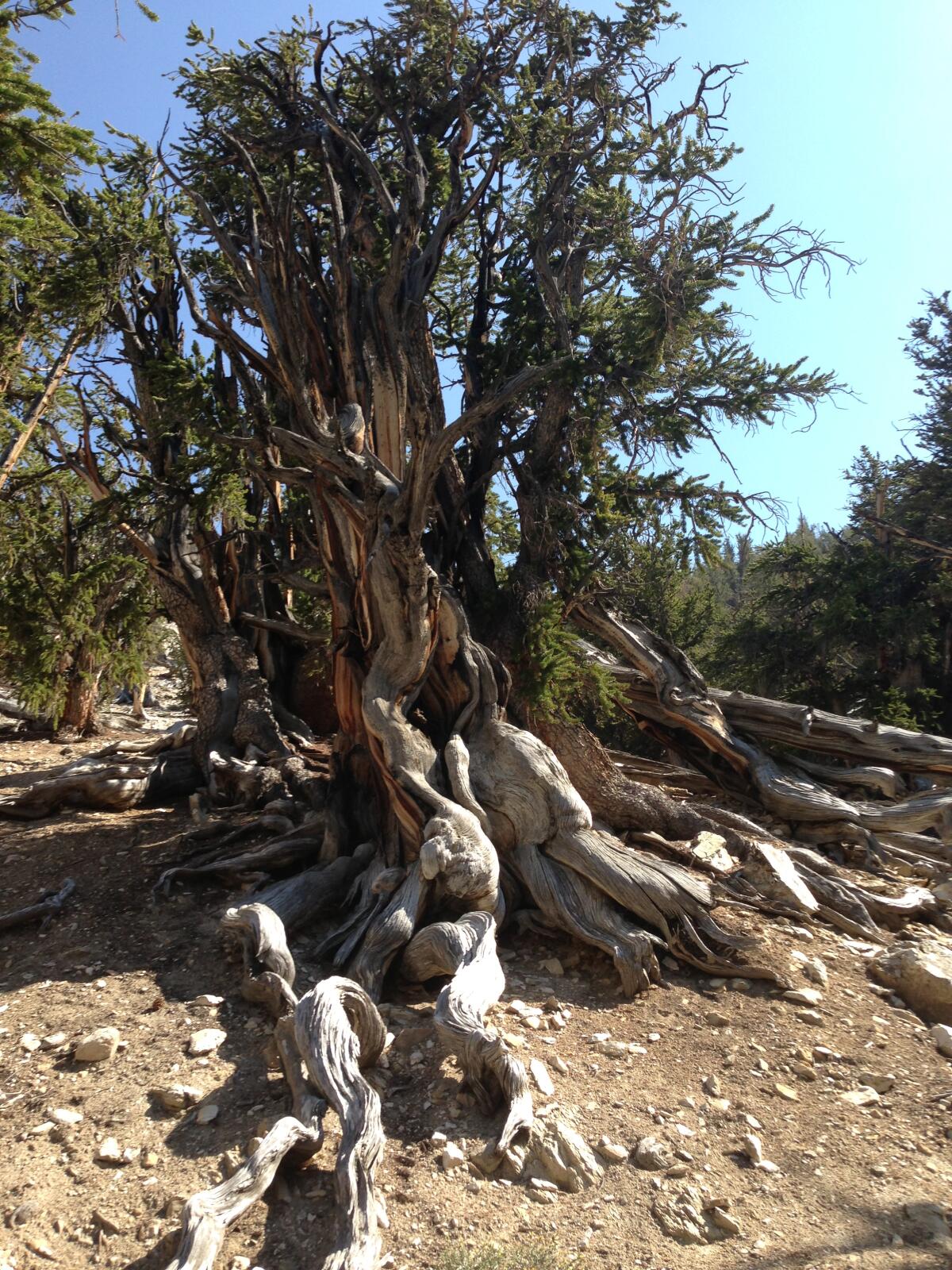We banned single-use plastic bags. Now we’re tossing more plastic. What gives?

- Share via
Good morning. It’s Tuesday, Feb. 13. Here’s what you need to know to start your day.
- California wanted to reduce how many plastic bags we throw away. A glaring loophole has been undermining progress.
- There are only 22 days until the California primary
- 22 romantic dining options for Valentine’s Day
- And here’s today’s e-newspaper
Sign up for Essential California
The most important California stories and recommendations in your inbox every morning.
You may occasionally receive promotional content from the Los Angeles Times.
Why are we losing the plastic bag war?
When state legislators passed a 2014 law banning single-use plastic bags, the hope was that it would notably reduce the amount of discarded plastic. But fast-forward nearly a decade: Californians are tossing more pounds of plastic bags than before the legislation was passed.
That’s according to a recent report by the consumer advocacy group CALPIRG, which took population changes into account and found the tonnage of discarded bags rose from 4.08 per 1,000 people in 2014 to 5.89 per 1,000 people in 2022.
How could this happen?
As Susanne Rust reported this week, plastic bag manufacturers replaced one kind of plastic bag for another. You’ve probably noticed them at grocery stores or had them loaded into your car during a drive-up order. These newer bags are thicker and meet technical specifications to be called “reusable.”
As Jenn Engstrom, CALPIRG’S state director, explained to Susanne, the switch created a loophole because the newer bags — which typically cost 10 cents — “are clearly not being reused and don’t look like reusable bags and … just circumvent the law’s intent.”
The pandemic was also a contributing factor. COVID restrictions led many to get groceries, restaurant dishes and other products delivered to our doors, often in thick plastic bags.
There’s an effort to close the loophole, though. New legislation is being proposed that would also ban the thicker plastic bags from grocery and large retail stores.
Individual habits vs. industry interests
Clearly, not enough consumers have changed their plastic bag habits at the checkout stand.
But the onus isn’t on individuals. Plastic manufacturers create these products. Businesses buy the bags so customers have somewhere to put the goods they buy from businesses.
A look back at the history of public messaging about pollution and who is responsible shows a concerted effort by business interests to shift the responsibility to consumers and away from the profit-making industries that produce the plastics. California is trying to change this with a recent law signed in 2022 by Gov. Gavin Newsom. The law puts more responsibility on companies that produce environmentally harmful plastics.
Under the new law, at least 30% of plastic items sold, distributed or imported into California must be recyclable by Jan. 1, 2028. It also stipulates that single-use plastic waste be reduced 25% by 2032.
But as Susanne pointed out, plastics companies will have notable oversight and authority over the program “via a Producer Responsibility Organization, which will be made up of industry representatives.”
Recycling blues (not the bins)
In the meantime, the systems in place to collect and recycle our plastic waste don’t inspire much confidence either.
“More than 35 million tons of plastics were generated in the United States in 2018 and only 8.7% was recycled,” according to the U.S. Environmental Protection Agency.
We’re in this sad state of recycling even as our plastic problems pile up, as Susanne noted:
“Plastic has been found everywhere scientists have looked: From the deepest oceanic trenches to the highest alpine peaks. Petroleum-based plastics do not biodegrade. Over time, they break down into smaller and smaller pieces — known as microplastics, microfibers and nanoplastics — and have been found in household dust, drinking water and human tissue and blood.”
It’s easy to see that statistic like the one from the EPA and think: “Why bother? Why work to change my consumption habits or improve my recycling efforts if it’s so dismal downstream?”
But there are actions we can take at an individual level to put less plastic into our environment. Some cities and agencies have shown progress in recycling some forms of waste, but we have a long way to go.
Now, we’d like to hear from you!
Tell us: How have your habits of reducing, reusing and recycling changed in recent years?
Do you bring your own bags on grocery runs and other shopping trips? Are you careful to recycle plastic products at home or out in the world? Have you formed habits that make that easier?
If so, what’s helped make a difference? If not, what has made shifting your habits difficult or discouraging?
Take this survey to share your experiences and you may see your responses in a future edition of the newsletter. Thanks!
Today’s top stories

Only 22 days until the California primary
- Democrats are emphasizing abortion to mobilize voters. Will it work in Orange County?
- From working with Black Panthers to calling for a cease-fire, Barbara Lee stands by her beliefs.
- Sparks fly in the second California Senate debate.
- What to know about the Senate candidates in California ahead of the primary election.
- Homeland Security Secretary Alejandro N, Mayorkas talks about impeachment, the border and growing up in L.A.
Crime and courts
- Liquor, Valium, speed and recklessness: The D.A.’s case against Rebecca Grossman.
- Two people were shot at a Super Bowl party in a rented Hollywood Hills home, police say.
- The L.A. County Sheriff’s Department is investigating four homicides after a violent night in southeast L.A. County.
Fallout from the storms
- Struggles to repair flood damage raise alarm about California’s next ‘disaster insurance gap.’
- Your house has water damage from the storm. Now what?
- After a brief reprieve more wet weather is on the way for Southern California.
- Striking satellite photos show California snow replenished by recent storms.
More big stories
- Golden state loses its luster: Half of Americans say California is in decline.
- Black and Latina workers bear the brunt of California’s low child-care wages, a report finds.
- California extends relief for homeowners who missed mortgage or tax payments.
- The body of a woman is found on Mt. Baldy a week after she went hiking alone during a storm.
- After an offseason makeover, can the Dodgers’ new-look rotation live up to preseason hype?
- UCLA hires DeShaun Foster as its football coach, replacing Chip Kelly.
Get unlimited access to the Los Angeles Times. Subscribe here.
Commentary and opinions
- LZ Granderson: If the economy is so great, why are evictions soaring?
- Opinion: Renting in L.A. could go from bad to worse.
- Michael Hiltzik: The climate scientist who just won a $1-million judgment against climate change deniers.
- Opinion: Cement is a big part of the carbon problem. Here’s how to make it part of the solution.
- Opinion: Many Americans believe migrants bring fentanyl across the border. That’s wrong and dangerous.
- Opinion: When my son stopped piano, I took over his lessons. Here’s how that went.
- Commentary: Stop pressuring Girl Scouts to be ‘cookie bosses.’
Today’s great reads
The prison that helped build ‘the city at the end of the world.’ Some call this prison the Alcatraz of Argentina. Its inmates helped build what’s now known as the city at the end of the world.
Other great reads
- AI bots told my dad I was dead. My fake obituaries sent me on a quest for answers.
- Why Bob Iger’s second act at Disney is looking brighter after a rough start.
- An unlikely friendship is tested by war. Can it survive?
How can we make this newsletter more useful? Send comments to [email protected].
For your downtime
Going out
- 🦞Thinking about romantic dining options in February? Our critic has 22 suggestions.
- 🍴They’re called ‘big pie.’ Where to find giant Chinese scallion pancakes.
- 🏈 When and where will Super Bowl LIX be played in 2025?
- 🎤 Veteran soul singer and civil rights activist Mavis Staples will celebrate her 85th birthday in Inglewood with an all-star tribute concert at YouTube Theater.
Staying in
- 🎧 Beyoncé announces her new album is on the way: Hear two songs now.
- 📖 Hollywood Behaving Badly, Chapter 47: Ed Zwick explains why his new book spills so much tea.
- 🧑🍳 Here’s a recipe for chocolate Valentine’s cake.
- ✏️ Get our free daily crossword puzzle, sudoku, word search and arcade games.
And finally ... a great photo
Show us your favorite place in California! Send us photos you have taken of spots in California that are special — natural or human-made — and tell us why they’re important to you.

Today’s great photo is from Michael Antonoplis of Sherman Oaks: a bristlecone pine tree. Michael writes:
My wife and I were traveling to Mammoth Mountain awhile back and decided to take a side trip to the Ancient Bristlecone Pine Forest off Hwy 395. We’ve always been fascinated by the trees, in which some of the trees exceed 4,000 years in age. The trip didn’t disappoint. These trees live in an extreme environment where the winds do not stop, the temperatures are very low, and limestone is the only food source. At 9,000 feet where the trees exist, the views to Death Valley were incredible!
Have a great day, from the Essential California team
Ryan Fonseca, reporter
Kevinisha Walker, multiplatform editor
Stephanie Chavez, deputy metro editor
PS: For the record: the Feb. 10 edition of Essential California said the 49ers haven’t won a Super Bowl in 19 years. They haven’t won a Super Bowl since Jan 29, 1995.
Check our top stories, topics and the latest articles on latimes.com.
Sign up for Essential California
The most important California stories and recommendations in your inbox every morning.
You may occasionally receive promotional content from the Los Angeles Times.





